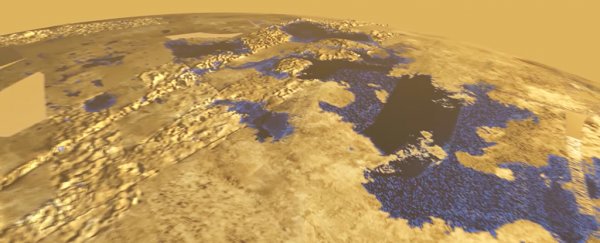If we're going to venture out beyond our home planet and start building colonies elsewhere, then one of the essential resources we're going to need is energy – and a new study says Saturn's largest moon, Titan, has it in abundance.
In fact Titan has enough energy sources to keep the lights on for a population the size of the United States, researchers say, including options for nuclear power, solar power, wind power and hydropower.
Amanda Hendrix from the Planetary Science Institute and Yuk Yung from the California Institute of Technology used the details we think we know about Titan and some maths based on similar technologies here on Earth to come up with their conclusions.
"Once propulsion challenges are overcome, allowing humans to travel great distances quickly without incurring significant radiation damage, Saturn's moon Titan is the optimal location in the solar system for an off-Earth human settlement," write the scientists.
That settlement would have to be self-sustaining, as Titan sits about 1.3 billion kilometres (808 million miles) away from Earth, but it has the potential to be used as a launchpad for missions that go even deeper into space.
Early robotic explorers could use nuclear power and radioactive decay as an energy source, and that might work for humans too, if we took up enough kit to build a plant and mined materials from the moon itself.
At the moment though, Titan's geology is too much of a mystery to be sure the nuclear power option would work.
What we do know is that there's plenty of methane on Titan – oceans of the stuff – which could provide rocket fuel as well as hydropower options. While the low-lying seas and a lack of rain mean rivers aren't often found on the moon, tidal power is a possibility.
Experts have spotted strong tides on Titan, created by the huge pull of Saturn, and those tidal changes all get squeezed through a small channel called Seldon Fretum or the Throat of the Kraken.
"The Throat of Kraken is basically the Strait of Gibraltar," planetary scientist Ralph Lorenz from Johns Hopkins University, who wasn't involved in the research, told New Scientist.
"We're pretty sure there's a very strong flow of liquid back and forth every Titan day. If you want reliable power that you know is going to be accessible, that's where I would go."
Even though Titan is almost 10 times further away from the Sun than the Earth is, solar power is an option according to the researchers behind the new study – as long as we can build enough panels.
The brightest a Titan day ever gets is similar to dusk on Earth, but Hendrix and Yung think a solar farm as big as the surface area of the United States would be able to support as many as 300 million people.
As for wind power, Titan does have strong winds in its upper atmosphere, according to measurements made by the Huygens probe. At the moment though, we don't have the technology to build floating wind turbines that could get up that high.
Indeed, one of the study's running themes is the need to refine and improve the technology we have here on Earth, from solar panels to turbines, ready for use on other planets.
With hydrocarbon fuels pretty much out of the question due to the lack of oxygen required to combust them, we're going to have to rely on these other options to support a base on Titan.
The study authors admit that they've skipped over some details in their work – we just don't know that much about Titan right now – but their report is a useful first step in working out how to make life liveable up on Saturn's biggest moon.
And the early signs are that Titan has enough natural resources to keep us going.
"While temperature, gravity and wind conditions on Titan mean that energy production efficiencies are generally lower than on Earth, Titan's wealth of natural resources nevertheless imply that energy production on Titan is a significant possibility," conclude the researchers.
The findings are due to be published in the Journal of Astrobiology and Outreach but until then can be found on the pre-print website arXiv.org.
